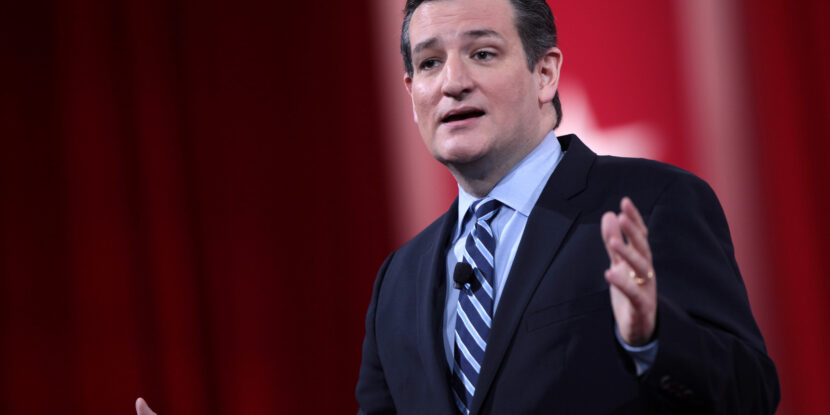
The Washington Post Wonkblog‘s Neo-Keynesian Matt O’Brien — who, aptly enough, tweets as @ObsoleteDogma — pauses to attack Neo-(Classical)-Liberal Ted Cruz in “Does Ted Cruz think his tax plan would cause a Great Depression?”
Spoiler alert. There’s a rule of thumb in journalism called Betteridge’s Law of Headlines. It states: “Any headline that ends in a question mark can be answered by the word no.”
So, the short answer is: no.
The center-right nonprofit Tax Foundation has scored Ted Cruz’s 10 percent flat tax (plus business transfer tax) as the most economic growth inducing of any of the presidential candidates’ tax proposals, generating 14 percent after tax income, over baseline, over 10 years.
By contrast, the Tax Foundation scores Donald Trump’ s plan as an 11 percent GDP increase, provided that the tax cut — meaning its $10 trillion in extra deficits, more than Obama’s — “could be appropriately financed.” The Tax Foundation scores Hillary Clinton’s tax plan as reducing GDP by 1 percent. Bernie Sanders tax plan? Negative 9.5 percent.
Now that’s a Great Depression! Matt O’Brien, call your office.
After making some rather hard-to-follow (but presumably 100 percent Obsolete Dogma compliant) arguments against Cruz’s tax plan, O’Brien goes on to observe:
So the Smoot-Hawlely tariff couldn’t have been the reason unemployment got up to 25 percent in the 1930s. The most you can say is that it might have added a couple of percentage points to that, but nowhere near as much as what really did cause the Depression. And what was that? Three things: a debt bubble, a banking crisis, and the gold standard. The simple story is that people borrowed a lot of money during the Roaring Twenties to buy houses, cars, furniture, sewing machines, and, by the end, stocks. So when the music stopped, which it did when the market crashed, everyone tried to pay back what they owed all at once. But that’s impossible. If too many people are trying to pay back their debts, then not enough people are buying stuff, and that can hurt the economy so much that people don’t even have the money to pay back their debts in the first place. That’s because, as Krugman puts it, my spending is your income and your spending is my income. Lower interest rates would normally keep this from getting out of hand by making paying back debts, aka saving, less attractive, but—sound familiar?—even near-zero rates weren’t enough to do that in the 1930s.
Bank runs only made this worse. It wasn’t just that people lost their money. Or that the economy lost its ability to channel money towards its most productive purposes. It was also that this scared people into trying to save even more money—just in their mattresses now—and, in the process, sucked even more spending out of the economy. And if all this wasn’t bad enough, the gold standard, which pegged the dollar and every other currency to the price of the shiny rock, spread this from one country to the next, and prevented any of them from doing anything about it. Why is that? Well, central banks couldn’t print money and governments couldn’t borrow much of it as long as their currencies had to be worth a certain amount of gold. That meant they couldn’t do a lot to fight recessions, which, in turn, made it a lot easier for them to turn into depressions—and in this case it did. Not only that, but countries that got into trouble ended up exporting it to others by forcing them to slash their own wages if they wanted to stay competitive. It’s no accident, then, that the countries that left the gold standard first were the ones that started to recover first.
Nicely enough, I (heterodoxically) agree with O’Brien about Smoot-Hawley. I never quite found the Smoot-Hawley tariff, as the precipitating factor of the Great Depression, a narrative spellbindingly woven by Jude Wanniski in the supply-side Bible The Way The World Works, quite persuasive. And for the exact reason that O’Brien states: that “unemployment got up to 25 percent in the 1930s. The most you can say is that it might have added a couple of percentage points to that, but nowhere near as much as what really did cause the Depression.”
That said, O’Brien, probably misled by what I have elsewhere called the “Eichengreen Fallacy,” completely overlooks the replacement of the classical gold standard by its only superficially similar “gold-exchange standard” in Genoa in 1922. This “interwar gold standard” is fully discredited and has been called by The Economist, quite correctly, “a mess” — as it did not apply the classical gold standard’s “rules of the game.” By 1929, the true gold standard had been gone for almost a decade.
There are persuasive reasons to believe that it was the defective interwar gold standard which fomented “… during the Roaring Twenties to buy houses, cars, furniture, sewing machines, and, by the end, stocks. So when the music stopped, which it did when the market crashed, everyone tried to pay back what they owed all at once” and was the primary driver of the Great Depression as the settlement mechanisms intrinsic to the rules of the classical gold standard had been disabled by its “evil twin.”
This explains more elegantly than does obsolete dogma why countries who left the gold standard started to recover first. When FDR, under guidance of the premier commodities economist of that era, George Warren, appropriately revalued the dollar from $20.67/oz to $35/oz, according to the definitive, Pulitzer Prize winning, history of that era Lords of Finance by Liaquat Ahamed:
Roosevelt’s decision to take the dollar off gold rocked the financial world. … Indignant bankers lamented the loss of the one anchor that could keep governments honest. Bernard Baruch, the noted financier, went a little overboard though when he said that the move, ‘can’t be defended except as mob rule. Maybe the country doesn’t know it yet, but I think we may find that we’ve been in a revolution more drastic than the French Revolution.’
But in the days after the Roosevelt decision, as the dollar fell against gold, the stock market soared by 15%. Even the Morgan bankers, historically among the most staunch defenders of the gold standard, could not resist cheering. ‘Your action in going off gold saved the country from complete collapse,’ wrote Russell Leffingwell to the president.
Taking the dollar off gold provided the second leg to the dramatic change in sentiment… that coursed through the economy that spring. … During the following three months, wholesale prices jumped by 45 percent and stock prices doubled. With prices rising, the real cost of borrowing money plummeted. New orders for heavy machinery soared by 100 percent, auto sales doubled, and overall industrial production shot up 50 percent.
Now, of course, despite FDR’s louche and grandiose claims to the contrary, he obviously, as a matter of well documented history, did not “take the dollar off gold.” Roosevelt appropriately, given the damage done by the interwar gold standard, revalued the dollar by about 50 percent.
It is much to be hoped that Matt O’Brien takes the time to remove the blindfold of the Eichengreen Fallacy and make the critical distinction between the classical gold standard and the defective and damaging gold-exchange standard. O’Brien’s is an important voice and it is a real shame when he allows himself to be muffled by obsolete dogma.
Ted Cruz’s proposed flat tax, plus business transfer tax, which has been scored as leading to optimal economic growth, and his prescription for the gold standard, if pointing to the classical gold standard, would lead to an era of sizzling equitable prosperity. Kudos to Cruz.
Ralph Benko, internationally published weekly columnist, co-author of The 21st Century Gold Standard, lead co-editor of the Gerald Malsbary translation from Latin to English of Copernicus’s Essay on Money, is American Principles Project’s Senior Advisor, Economics.


